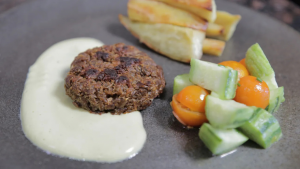From the Series
Brent Richards is an award-winning architect, designer and polymath specialising in sensory and food design, who has previously consulted for Heston Blumenthal. He is currently CEO and creative director at the Design Embassy Europe creative consultancy.
There is a definitive scene in Charles Dickens’s Oliver Twist, when the nine-year-old Oliver, a resident in a workhouse where the boys are issued three meals of thin gruel a day… Asks for more!
Child as he was, [Oliver] was desperate with hunger, and reckless with misery. He rose from the table; and advancing to the master, basin and spoon in hand, and said somewhat alarmed at his own temerity:
“Please sir, I want some more.”
The master was a fat healthy man; but he turned very pale. He gazed in stupefied astonishment on the small rebel for some seconds, and then clung for support to the copper. The assistants were paralysed with wonder; the boys with fear.
“What!” said the master at length, in a faint voice.
“Please sir,” replied Oliver, “I want some more.”
(Extract from Oliver Twist at www.charlesdickens.com/twist_more)
Even though this scene is from the Victorian era and can seem remote, it captures the significance of food to our livelihood, and its affective relationship with our persona and sense of well-being. In Oliver’s case, it may be devoid of culture and community, but it is profound need that supersedes the state of the food and its modest context.
Contrast this with the 21st-century molecular high cuisine of Heston Blumenthal, internationally acclaimed three-Michelin-star chef of the Fat Duck Restaurant, Bray, in the United Kingdom. On the list of his experiential tasting menu is a rare dish, snail porridge.
In essence it is a translation of congee, a rice gruel, that has been elevated in status by the imaginative culinary insight of combining it with helix pomatia, otherwise known as vineyard snail, to conjure a snail and oats dish. While there may be an instinctual reluctance to eat the land borne mollusc, their gastronomic status was firmly established by the Romans and first appears as a French recipe in 1390.
The development of the snail porridge dish was both technically and emotionally demanding as it provides a surreal, eccentric image and theatricality to a dish you cannot make sense of, or your previous learned taste does not have a memory of. However, it is when need is not paramount and desire can be teased by the imagination, that we are in the realm of food and eating design and the land of food culture. (Interesting that the Slow Food logo is a snail too!)
“Expectation plays an enormous part in our experience of food, but the result tastes absolutely delicious, and it offers an insight into how we approach what we eat,” writes Blumenthal on snail porridge in his 2008 The Big Fat Duck Cook Book.
Food is culture and everything has to do with food in one way or another; agriculture, economy, medicine, science and technology, even our social fabric, can be considered an active embodiment of our relationship to food. Whether in times of famine or plenty, food culture influences how, where, when and what we eat.
The act of eating, of consumption, is both deeply personal at an emotional and physical level, and as a shared act on the communal and collective level, as well as a true manifestation of our human sensibility to interact and bond. The shared act of eating unifies both our rituals and customs, and fundamentally influences our daily happiness and longer term well-being.
However, we should distinguish between the “need for daily sustenance” and the “wish for nourishment”, to better understand the difference between our needs and desires. The fact that we all eat, does not make us all designers of food, though we individually may be cooks, chefs, connoisseurs and, in some cases, gastronomes.
The act of design is more than simply about interaction and participation. It’s about overview, critical analysis and aesthetic appreciation; an overarching understanding and awareness of using aesthetic aptitude to configure, arrange and present food in an imaginative attractive fashion. To imbue food products with values and a relationship to origin and process, to communicate and package food stuffs in an intriguing and authentic manner, and to facilitate and heighten the relationship between nature, cooking and eating… is to truly ask for more.
But at its very basic level, food and eating are primal functions, a need that is necessary to fulfil on order, to exist and survive from one day to the next. To live, we need to plan, select, cultivate, nurture and care for the food we eat and absorb into our bodies. It is a lack of money that lessens choice, variety and value. It is only when we have more than enough, a surplus (in pure economic terms), that we can start to care and share with our neighbour; to choose, have preferences, seek freshness, variety of type, and determine a basis for diet and nutritional benefits.
Once we desire food as “lifestyle”, we are no longer serving primal physical need, but rather engaging in a physiological and psychological relationship with our body. Emotion, memory, senses, physiognomy and physicality are manifest in our self mind-body image, and food becomes the transformative agent that can positively reinforce food choice and philosophy, or detract and conceal body dysmorphia like anorexia and bulimia. In this sense, food codifies our status, geography, sex, religion and cultural positioning.
In an era of body instability when bodies have become less about functionality and more about image, food culture itself is less about physical activity in cultivation, preparation, cooking and service, and more about intensive science, mechanised production, mass bulk transportation and packaged self-contained solutions.
We therefore have a conflict between mind and body; between self and family or community; between individual tastes and preferences, and shared taste; and between the global packaged branding of identical hands-off food and the homespun limited-edition seasonal hands-on food.
Food has always been a driver of human civilisations, from humans following wild herds as hunter-gatherers, working the land as subsistence farmers, to selective roles refining storing and preserving between seasons, to trades people preparing, combining and baking food to barter or sell to others. By 2020 over 70% of the world’s population will live in cities or urban conurbations, while despite being efficient and smart at food production, our economic dilemma remains. Who is going to grow the foodstuff, how can it be made accessible at an affordable price, and who will control what and how we eat? Technically, with global cooperation we can resolve most of these needs, but once we have sufficient food on our plate, we also wish to desire what we eat, to cultivate our appetite and feed our minds.
For this we require more than wholesome agricultural practice, good natural raw ingredients and clever cooking utensils. We have to create and maintain a culturally diverse, sustainable, authentic and rich food culture that is about conviviality, sharing, joy and amusement, not to mention interaction that is spontaneous and unexpected.
Like snail porridge, it should test our sensations, enrich our experience, play with our senses, and add happiness to living and dining together. While we are caught in the maelstrom of meeting the needs of fast living and fast consumption, and we desire more time to enjoy the quality rather than quantity, we should bare in mind the snail. Still, slow… but adventurous!







